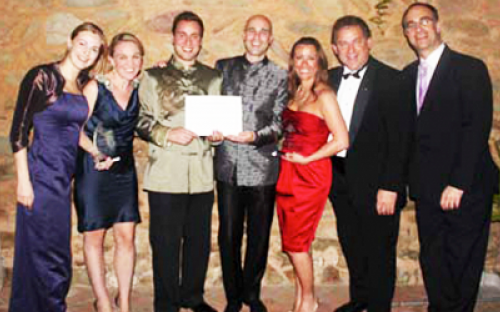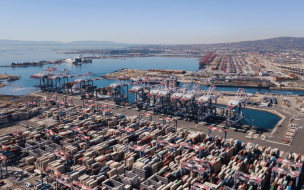When a group of CEIBS MBA 2010 classmates decided to make CEIBS’ Shanghai campus “carbon neutral” as their Responsible Leadership Project, the idea led to an international award on responsible leadership, a pilot project grant, a historic announcement, and the passionate support of the CEIBS community. Now comes the hard part: turning the ambitious plan into reality.
On May 28, 2011, speaking to a full auditorium of more than 250 students, sustainability experts, and members of the media gathered at the CEIBS Shanghai campus for the 6th annual Being Globally Responsible Conference school Executive President Zhu Xiaoming made a historic announcement: CEIBS had become the first business school in Asia, and one of the very few top tier b-schools worldwide, to achieve “carbon neutral” status. The announcement represented the culmination of nine months of rigorous research and passionate campaigning from a team of MBA 2010 students – aka “the Decarbonators.”
The team’s mission: to accurately calculate the school’s carbon footprint, then create a viable plan for reducing and off-setting the school’s greenhouse gas emissions in order to minimize CEIBS’ impact on climate change. In a ceremony held during BGRC, the school officially purchased a series of carbon credits equal to the residual amount of greenhouse gas emissions produced in one year (those not reduced by on-campus reduction measures). With this, the CEIBS Shanghai campus effectively achieved “carbon neutrality” for the coming 12-month period.
The project required painstakingly detailed input from dozens of sources at CEIBS, plus gaining the support of the student body as well as the very top levels of the school’s Management Committee. Upon hearing of the student’s successful endeavors, CEIBS Vice President and Dean John A Quelch said: “It is terrific to have a group of CEIBS students shaping the strategic direction and vision of the school. Achieving carbon neutral status solidifies CEIBS’ position as the foremost proponent of responsible leadership among business schools in Asia.”
How did it all start?
When the Decarbonators started on their journey back in September 2010, none of the original group members – Robert Seiler, Alex Song, Yusuke Ozeki, Don Ni, and Michelle Da – could have imagined the doors that would be opened by the project.
But first came the grueling work of creating an accurate carbon footprint of the full CEIBS Shanghai campus. As the group soon learned, achieving this goal would test all of their b-school skills: from business strategy, human resources and marketing, to innovation and project management, plus the heavy-duty mathematical calculations.
Step 1: Measuring the Carbon Footprint
To analyze the campus carbon footprint (total greenhouse gas emissions for the calendar year 2010), the group relied upon the expertise of team member Dr Robert Seiler, whose pre-MBA background includes a PhD in Physical Chemistry from MIT and ETH plus six years of experience conducting consulting work on carbon emissions in Italy, Austria, Germany and Switzerland. The team also drew upon contributed expertise from four partner companies: carbon auditing firm SGS, environmental protection NGO WWF, China-based solar panel producer Trina Solar, and Chinese technology firm and air conditioning experts DunAn. Using these resources, the students set out to measure the campus’ greenhouse gas (GHG) emissions from seven key sources: waste paper, food waste, nonfood waste, steam, fuel, water and – most significantly – electricity.
Gathering solid data required time consuming input from a host of CEIBS departments, from Logistics to Engineering to Marcom. Alex Song took charge of liaising with the school’s logistics personnel to introduce the project (often to an audience unfamiliar with carbon emission issues), then requested detailed information never before shared with students.
Why did the team put so much effort into this project?
“The fundamental difference between our RLP and the rest is that we commit to make a business case and try to execute the project by the end of our stay in CEIBS,” says Alex. “That’s why we put tremendous effort into the data collection and liaising with stakeholders.” He says most challenging was to win support from all the different stakeholders involved, which required introducing the project again and again, to build up support and trust from scratch.
The final calculation resulted in a formal tally of 4,500 tons of greenhouse gas emissions (or CO2- equivalents) from the Shanghai campus each year (see chart, “CEIBS Carbon Footprint”). This is equal to the CO2 emissions produced by traveling around the world by car 500 times, or by Boeing 737 more than 2.5 times. In other words, absorbing the greenhouse gasses produced by CEIBS Shanghai campus in one year would require the planting of 16,000 carbon-absorbing trees.
The good news is that, once the carbon footprint was calculated, the students began researching ways to reduce it by saving energy and reducing emissions – and cutting costs. Along the way, the project also allows CEIBS to demonstrate its commitment to the core value of sustainability. As the students stated in their final RLP report: “The largest benefit for CEIBS when realizing this business plan will not be financial, but in terms of reputation and credibility on the path of becoming the centre for sustainability among international business schools.”
As it happened, international recognition for the project came much quicker than the students expected...
Step 2: Competing in Barcelona
In April 2011, just after completing the RLP, the project led to an unexpected opportunity: a chance for the student team to compete in, and win, the annual Global Business Forum (GBF) business school competition. To form the CEIBS team, Robert Seiler attracted a new recruit to the Decarbonators: MBA classmate Eric Seidner. The duo spent March 30 to April 2 at the GBF 2011 competition held at ESADE in Barcelona. During the competition, which attracted 130 student government leaders and alumni from the top 50 global b-schools worldwide, the CEIBS team so impressed the judges that the GBF created a prestigious new category, the “Responsible Leadership Award and Grant.” As the debut recipient of this award, the CEIBS team received a grant of US$2000, sponsored by Cisco and Thomson Reuters, to promote the carbon neutral initiative.
During their acceptance speech, Seiler and Seidner said the unique aspects of the CEIBS curriculum and the support from the students and administration were critical in shaping the project. The GBF has also invited Seiler, Seidner and Song to attend the 2012 Graduate Business Conference as expert panelists. In this way, the CEIBS team will be able to use this award as a platform for spreading the sustainable mindset to other top MBA schools.
Step 3: Planting Trees in Inner Mongolia
With their GBF award and pilot project grant in hand, the students next won the support for an ambitious new venture: a tree-planting mission to Inner Mongolia. In early April, supported by donations from their MBA classmates and an advance for air tickets from the MBA Office, Decarbonators Seiler and Seidner set out to help offset CEIBS’ carbon emissions by joining an annual tree planting mission to the severely deforested farming region of Kulun Qi.
After taking a two-hour plane trip from Shanghai to Shenyang in Liaoning Province, then a 4.5-hour bumpy bus ride, the CEIBS students arrived in one of China’s poorest and harshest regions. The duo was there from April 22 to 25 in order to start the planting of the “CEIBS Forest” with the first 1000 trees – a venture that not only absorbs CO2 but also combats desertification of the soil, helping local farmers to regain sustainability.
Was the value of planting trees in these regions obvious when you got there?
“The desert was knocking on the doorsteps of most of the houses. We had to travel by horse drawn cart because some of the roads were swallowed up by sand,” Seidner said. “The farmers in that region depend on reforestation to try to reclaim their land and their livelihood.”
The trees not only create a windbreak to reduce sandstorms, but also assist the local population in reclaiming arable land for planting crops. In addition, the new forest provides local farmers with a sustainable timber industry. Because poplar trees cease absorbing carbon efficiently when they reach maturity, they must be harvested and replaced with saplings. This cycle creates a viable new source of income for farmers while helping the environment.
How were you received by the farmers of Kulun Qi?
“The local people were incredibly friendly,” remembers Seiler. “They worked alongside us with tractors and donkey carts. They were absolutely into the project because they understand the problem. The trees are literally being planted between the desert and their houses.” Such concrete benefits for the programme more than made up for physical hardships of the volunteers, who sometimes returned to their hostel after 12 hours of tree planting only to find no hot water left for showers.
Going forward, the new CEIBS Forest will be maintained by local farmers, and the students report a91 percent survival rate for the trees. Any tree that fails to grow will be replaced, guaranteeing that the CEIBS Forest always holds at least 1,000 trees. And because each tree will absorb 250 kilograms of CO2 during its 15- to 20-year lifetime, the new forest will allow CEIBS to “offset” 250,000 kilograms of greenhouse gas emissions. The offsetting capacity will expand yearly, as the CEIBS Forest expands.
What was the out-come?
“This was an excellent cultural experience. We were able to work with local farmers, learn about their communities and experience Mongolian traditions,” said Seidner, adding that the Decarbonators are determined to make expanding the CEIBS Forest an annual effort. “We will make sure this becomes a yearly tradition at our school and we hope to plant several thousand trees next year. Because this is a hands-on experience, we will make sure to secure more spots for CEIBS students to participate.”
While planting the CEIBS Forest represented a good start toward carbon offsetting, a much larger effort had to be made to achieve Carbon Neutrality. With the backing of the school’s Management Committee secured, the Decarbonators next looked to carbon broker Evolution Markets for advice on purchasing carbon credits to offset the residual emissions of the campus that could neither be reduced nor absorbed by trees. Two projects emerged as worthy of a donation from CEIBS: a small hydropower project managed by Guizhou-based Liupanshiu Tuoyuan Group, and Xinjiang Dabancheng Sanchang Phase III Wind Power Project managed by Xinjian Tianfeng Wind Power Co.
These were the two projects CEIBS supported in the May 28 donation of carbon credits necessary to off set the residual emissions. These projects not only support the local population in the rural areas of the Guizhou and Xinjiang provinces, but also bring another social benefit: Part of the money invested is used to educate local children on environmental protection and sustainable living.
Step 4: Back on campus – reduce, rethink emissions
With the CEIBS Forest planted, and Carbon Neutral status attained for the coming year, the Decarbonators now face the most difficult work of all: ensuring that the project continues after the original MBA 2010 team graduates. Says Song: “The most challenging task for us now is figuring out how to implement the emission reducing measures in a systematic and persistent approach in the following years. Carbon neutralization is not a one-year project. We need to identify some systems to integrate the practice into CEIBS’ blood!”
For one thing, when the team members head to the Global Business Forum competition in March 2012, they must not only show that the pilot project was successfully launched but also prove that CEIBS is now committed to continually achieving Carbon Neutral status annually. Says Seidner: “When we got the award from GBF, the organizers kept stressing one thing: legacy, legacy, legacy. We have to make sure that achieving Carbon Neutrality is not a one-off thing.”
For the remaining nine months of their MBA studies, the Decarbonators will focus on two aspects of the Carbon Neutral Project: reducing emissions at the CEIBS Shanghai campus, and laying the foundation for continuing work on this project by the incoming MBA 2011 group. Toward that end, Seiler, Seidner and Song joined an ongoing student club, the CEIBS Energy & Environment Club, and are working with the MBA Office on creating a permanent position within the MBA Student Committee to oversee the club and its new focus on maintaining Carbon Neutrality for CEIBS Shanghai campus.
In terms of reducing and rethinking greenhouse gas emissions, the Energy & Environment Club is focusing on two projects this spring. First, the club identified two “quick wins” to efficiently cut GHG emissions through electricity usage. The students seek to plug the large “gaps” surrounding many of the glass doors on campus – gaps that greatly reduce energy efficiency by allowing hot air to flow in during the summer, and cold air to enter during the winter. CEIBS corporate partner Haworth is assisting in sourcing suppliers of a workable sealing product. When done, the students calculated this process could reduce total GHG emissions on campus by 2.5 percent. The second “quick win” recommended by the students is to install motion sensors throughout the campus which will automatically switch off lights in empty rooms, saving the campus another 0. 5 percent of total emissions.
Other emission-reducing projects under consideration are: installing a new energy efficient air conditioning, increasing the indoor plants on campus, and planting more trees. In addition, the Decarbonators are exploring the use of solar paneling on the Shanghai campus.
What do you think will be the hardest challenge?
“The hardest challenge will be the behavioral campaign,” says Seiler. “It is one thing to give a talk and inspire people. A good talk can affect people for a while, but that inspiration diminishes over time. And when people are used to doing things in a certain way, they form unconscious habits. We will have to keep reminding and coaching everyone who lives, works, or studies on campus.”
To build lasting enthusiasm, the Energy & Environment Club plans to launch a series of energy saving competitions, for example urging friendly competition between MBA classes or dorm buildings, EMBA groups, or administrative departments to see which group saves more energy. While the ambitious task sometimes seems daunting, the Decarbonators have been energized by the positive response to the initiative, especially from fellow students. Alex Song sums up the reception from CEIBS classmates: “The only word that is appropriate to describe the students’ reaction: “proud”. We are the pioneers and we are innovative!”

Follow progress of the Decarbonators, aka CEIBS Energy & Environment Club, on the CEIBS website. Or turn to Google maps to check in on the growth of the CEIBS Forest
RECAPTHA :
dd
d9
fd
9a







